Fire in the Steppe:
The Battle, Part Four
by Mike Bennighof, Ph.D.
October 2021
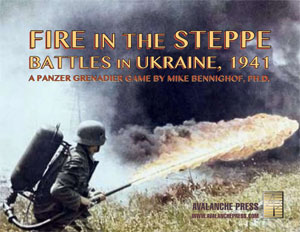 Despite the massive scope of Operation Barbarossa, the Axis invasion of the Soviet Union with millions of men along a front stretching from the Arctic Ocean to the Black Sea, Fire in the Steppe puts its focus on just one small sector of that front. At the small cities of Brody and Dubno, six Soviet mechanized corps under the command of South-West Front rolled forward to challenge the three panzer corps of First Panzer Group. What followed would be the Second World War’s largest tank battle (the measurement depending on how you want to account for Soviet tanks that broke down before they made it into action). Despite the massive scope of Operation Barbarossa, the Axis invasion of the Soviet Union with millions of men along a front stretching from the Arctic Ocean to the Black Sea, Fire in the Steppe puts its focus on just one small sector of that front. At the small cities of Brody and Dubno, six Soviet mechanized corps under the command of South-West Front rolled forward to challenge the three panzer corps of First Panzer Group. What followed would be the Second World War’s largest tank battle (the measurement depending on how you want to account for Soviet tanks that broke down before they made it into action).
Nowhere is that tight focus more evident than in Chapter Three of Panzer Grenadier: Fire in the Steppe, which features some of the most intense action in the game (and in pretty much all of Panzer Grenadier). It takes place on just one day, 28 June 1941 (St. Vitus’ Day), in just one sector, that in which the Soviet VIII Mechanized Corps and faced the German 48th Motorized Corps. Let’s have a look.
St. Vitus’ Dance
The climax of the Soviet counter-attacks came on 28 June, St. Vitus’ Day. The attacks of 8th and 15th Mechanized Corps against the southern flank of the German penetration had enjoyed some success, inflicting casualties and causing delay. Trying to build on that success, South-West Front ordered 8th Mechanized Corps to pull itself out of the line and attack to the north-west, into the open right flank of the German 16th Panzer Division advancing to its south-east. The Germans had run into tough resistance from Soviet cavalrymen, and Mikhail Kirponos of South-West Front apparently hoped to strike them with his armor while they remained pinned by the cavalry.
The Red Army of a few years later, fighting the German Army of a few years later, likely could have pulled off a signal victory with that maneuver. But the Soviets needed far too much time to re-orient their front, and attacked with only part of the intended forces. Meanwhile the Germans reacted promptly to trap the Soviet spearhead. The operation now became one aimed at relieving the encircled Soviet tank units.
All of the Soviet mobile divisions had taken enormous losses, greatly eroding their combat power, and they would have no opportunity to receive replacements. The Germans for their part had been forced to commit reserves far earlier than planned: all three of 48th Motorized Corps’ divisions had seen action, and soon 14th Motorized Corps would enter the front lines as well.
On 28 June both sides would go on the offensive, resulting in an unprecedented series of battles along the Brody-Dubno front.
Scenario Eighteen
The Seventh to the Rescue
28 June 1941
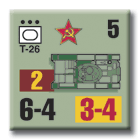 Commissar Nikolai Popel’s battle group had succeeded on the 27th in large part thanks to poor German deployment. By the time the other two divisions of Eighth Mechanized Corps had extracted themselves from their front and shifted eastwards behind the Soviet lines to attack, the Germans had corrected their mistake. Popel and 34th Tank Division were now trapped behind enemy lines. Col. A.V. Gerasimov sent the first arriving battalion of his 7th Mechanized Division forward, along with support from his tank regiment and an artillery battalion, before the Germans could further reinforce their positions. Commissar Nikolai Popel’s battle group had succeeded on the 27th in large part thanks to poor German deployment. By the time the other two divisions of Eighth Mechanized Corps had extracted themselves from their front and shifted eastwards behind the Soviet lines to attack, the Germans had corrected their mistake. Popel and 34th Tank Division were now trapped behind enemy lines. Col. A.V. Gerasimov sent the first arriving battalion of his 7th Mechanized Division forward, along with support from his tank regiment and an artillery battalion, before the Germans could further reinforce their positions.
Conclusion
While German anti-tank weaponry proved mostly useless against modern Soviet tanks, Gerasimov’s division had none of these, only lightweight BT fast tanks. The 300th Motorized Infantry Regiment pushed back the German defense at least ten kilometers, but did not advance far enough to free 34th Tank Division from entrapment. With reinforcements, it appeared that the Soviets could make their breakthrough.
Notes
This is a relatively small scenario, with just one map board and battalion-sized forces on each side. Seventh Mechanized Division has been battered, but remains a potent combat formation. Priority among the divisions for receipt modern tanks seems to have been fairly haphazard, other the tank divisions receiving theirs first. The German PzJr 1 makes an appearance here, and its Czech-made 47mm gun can deal with the Soviet BT-7 light tanks.
Scenario Nineteen
Ryabishev Returns
28 June 1941
Some hours after committing the vanguard of 7th Mechanized Division, VIII Mechanized Corps commander D.I. Ryabishev had gathered enough of his two remaining divisions to renew the attempt to relieve his trapped 34th Tank Division. By the time the Soviet attack jumped off across the Plyashevka River, the Germans had reacted to Gerasimov’s morning attack and infantry with strong anti-tank forces had infiltrated into the gap that had opened between Ryabishev’s advanced forces and the main body.
Conclusion
The 16th Panzer Division was one of the few German formations to wield the new PAK38 50mm anti-tank gun; these proved little more effective against the KV-1 than the 37mm “door knocker.” The Soviet battle groups – they could no longer truly be considered divisions - pressed forward relentlessly, but the Air Force 88mm heavy anti-aircraft guns pressed into a ground role destroyed 22 Soviet tanks by themselves. Ryabishev finally ordered a withdrawal during the night, and South-West Front soon ordered the remnants of VIII Mechanized Corps to pull back from the front.
Notes
Now we get some tank action, with masses of Soviet tanks flung into a brutal frontal assault against German 88mm anti-aircraft guns. The Soviets have masses of tanks in this large scenario, but have to coordinate forces from two different divisions. The Germans have the big 88mm guns, and the 50mm anti-tank guns are pretty deadly, too.
Scenario Twenty
Infantry Attacks
28 June 1941
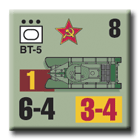 Ewald von Kleist, commander of Panzer Group One, had not expected such vigorous counter-attacks from the Soviet South-West Front. When his divisions reported that the Soviet VIII Mechanized Corps had shifted its front from its northerly assault on Leshniv to make a new attack toward Dubno to its north-east, Kleist saw an opportunity to strike the enemy corps’ exposed left flank. But it was less exposed than he assumed. Ewald von Kleist, commander of Panzer Group One, had not expected such vigorous counter-attacks from the Soviet South-West Front. When his divisions reported that the Soviet VIII Mechanized Corps had shifted its front from its northerly assault on Leshniv to make a new attack toward Dubno to its north-east, Kleist saw an opportunity to strike the enemy corps’ exposed left flank. But it was less exposed than he assumed.
Conclusion
The 212th Mechanized Division had been formed in April and had no transport vehicles, no artillery and little will to fight. South-West Front, aware of these shortcomings, had removed it from XV Mechanized Corps and placed it behind the lines, dug in along the Slonivka River to screen the re-deployment of VIII Mechanized Corps. Struck by two full-strength German infantry divisions, the Soviet formation crumbled and within hours the Germans had occupied the important town of Brody.
Notes
Something a little different, a large-scale infantry battle with the Germans on the attack backed by plentiful artillery plus air power. The Soviets are outnumbered and out-moraled, with no artillery at all, but the Germans have to accomplish a lot in order to win.
Scenario Twenty-One
Like a Spear
28 June 1941
Just to the west of VIII Mechanized Corps, XV Mechanized Corps pressed forward as well in what was intended to be a diversionary attack to assist the main effort. The two tank divisions of XV Mechanized Corps had suffered serious losses and the corps had lost its commander, Ignaty I. Karpezo, who had been seriously wounded. But 10th Tank Division remained a potent combat force thanks to its veteran cadre.
Conclusion
The defenders could count on massive Luftwaffe air support, what with Hermann Goering’s personal regiment in the front lines. The Germans had also augmented their anti-tank defenses not only with the big 88mm weapons of the Luftwaffe anti-aircraft gunners but also howitzers from their divisional artillery regiment. These heavy weapons gave them the means to combat the thickly-armored Soviet tanks, which came at them with little coordination. “Enemy shells could not penetrate our armor,” wrote Capt. Z.K. Slyusarenko of the 19th Tank Regiment, “but they could break the tracks and destroy the turrets. The KV to the left of me is bursting into flames. A plume of smoke shot into the air above the tank, with a thin shot of flame from right in the core, like a spear.”
Notes
A massive Soviet tank attack against German infantry, with the defenders dug in and supported by a full battalion of 88mm anti-aircraft guns. The Germans are trying to escape without serious damage to their own forces while inflicting casualties on the attackers; the Soviets are fighting to kill or expel the invaders at whatever cost (casualties mean nothing for victory purposes).
Scenario Twenty-Two
Directive 018
28 June 1941
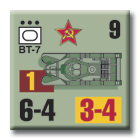 On the morning of 28 June, South West Front’s chief commissar, Nikolai N. Vashugin, closed his office door and shot himself. Within minutes, front commander Mikhail Kirponos threw out pre-war doctrine that called for only the mechanized corps to conduct counter-attacks, and ordered his rifle divisions to join the effort. The new front commissar, Nikita Khrushchev, endorsed the change but few of these formations were in position to join the tankers on the attack. One division that could be ordered forward was the XV Mechanized Corps’ 37th Tank Division, which entered the line to the right of 10th Tank Division. On the morning of 28 June, South West Front’s chief commissar, Nikolai N. Vashugin, closed his office door and shot himself. Within minutes, front commander Mikhail Kirponos threw out pre-war doctrine that called for only the mechanized corps to conduct counter-attacks, and ordered his rifle divisions to join the effort. The new front commissar, Nikita Khrushchev, endorsed the change but few of these formations were in position to join the tankers on the attack. One division that could be ordered forward was the XV Mechanized Corps’ 37th Tank Division, which entered the line to the right of 10th Tank Division.
Conclusion
The 37th Tank Division had a very strong leadership cadre including its commander Col. F.G. Anikushkin. The division had not yet seen combat and had avoided excessive losses to air attacks and breakdowns, and went into battle with nearly its peacetime strength. Unfortunately, that still left it short of infantry and transport vehicles, forcing it to leave a good part of its artillery behind. That put the burden of the attack on its plentiful but weak allotment of BT light tanks. Anikushkin’s men got across the Styr River and made progress but faltered at the second water barrier, the smaller Ostrovka River, without sufficient artillery support to destroy German anti-tank positions.
Notes
Those 88mm guns are everywhere, and they’re going to be needed if the Germans hope to stop the rampaging Soviet armor. Six days into the invasion a fresh tank division makes its appearance, with solid morale, good leadership, high initiative and artillery support. This one is going to be tough for the Germans, but the Soviets have ambitious objectives to reach for victory.
Scenario Twenty-Three
Shoulder Roll
28 June 1941
On the southern “shoulder” of the German penetration, the German XIV Motorized Corps had held its positions and allowed the troops further north to spearhead the penetration. When Soviet tank divisions began their counter-attack into the German right flank, Gen. Gustav von Wietersheim’s corps launched its own counter-attack into the Soviet left flank, held by Maj. Gen. M.F. Maleev’s 3rd Cavalry Division.
Conclusion
The cavalrymen had no answer for a massed panzer attack, and for this reason, Sixth Army headquarters had detailed 32nd Tank Division to provide them support. That assignment took South-West Front’s most powerful mechanized corps away from its intended operational mission, but might have yielded some benefit had the tank division been capable of carrying out its orders. Though lavishly equipped with new tanks, the division had only been raised in the spring and lacked officers, prime movers and most of all communications gear. It never made it to the battlefield, and Ninth Panzer Division swept through the Soviet defenses, rendering useless the heroic sacrifices of the tank divisions just to the east.
Notes
The Soviet cavalry are pretty tough, but badly out-gunned and out-numbered. They need those tanks to show up; the red tread heads have plenty of modern tanks but aren’t all that sure how to use them, lacking morale and leaders. Part of the Red Army’s story in June 1941 is the deployment of excellent new tanks with raw formations, while veteran divisions are still operating lightweight BT tanks.
Scenario Twenty-Four
The Commissar’s Command
28 June 1941
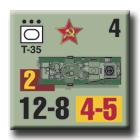 Trapped within a pocket southwest of Dubno, within sight of the small city, VIII Mechanized Corps Commissar N.K. Popel held command of a battle group built around 34th Tank Division and some 12th Tank Division troops. Popel had clear orders: continue his drive on Dubno, while corps commander D.I. Ryabishev drove away the Germans encircling Popel’s force. Sorting out the forces and issuing fuel and ammunition took far longer than planned, but finally the Soviets advanced. German reinforcements reached the city two hours before Popel finally attacked. Trapped within a pocket southwest of Dubno, within sight of the small city, VIII Mechanized Corps Commissar N.K. Popel held command of a battle group built around 34th Tank Division and some 12th Tank Division troops. Popel had clear orders: continue his drive on Dubno, while corps commander D.I. Ryabishev drove away the Germans encircling Popel’s force. Sorting out the forces and issuing fuel and ammunition took far longer than planned, but finally the Soviets advanced. German reinforcements reached the city two hours before Popel finally attacked.
Conclusion
Between the late start and the lack of artillery support, the Soviet attack had little chance of breaking into Dubno. Fanatical bravery by the tank crews brought the armored portion of the force into the fringes of the city, but without enough infantry to fend off the German close-assault teams. Lacking artillery of their own, the Soviets could not easily drive away the German artillery batteries firing at point-blank range as stand-in anti-tank guns.
Notes
We wind up this chapter with another appearance by the T35 land battleships. They have outstanding morale in this scenario, and special rules instilling fear in the heart of the Aryan invaders attempting to confront them. Fire in the Steppe is worth playing just for all the T35 scenarios.
And that’s the third chapter of Fire in the Steppe.
You can order Fire in the Steppe right here.
Sign up for our newsletter right here. Your info will never be sold or transferred; we'll just use it to update you on new games and new offers.
Mike Bennighof is president of Avalanche Press and holds a doctorate in history from Emory University. A Fulbright Scholar and NASA Journalist in Space finalist, he has published an unknowable number of books, games and articles on historical subjects.
He lives in Birmingham, Alabama with his wife, three children and his dog, Leopold.
Want to keep Daily Content free of third-party ads? You can send us some love (and cash) through this link right here.
|
